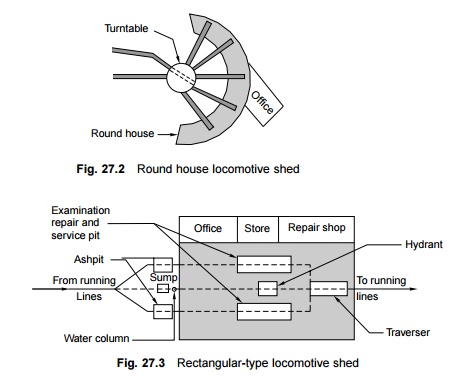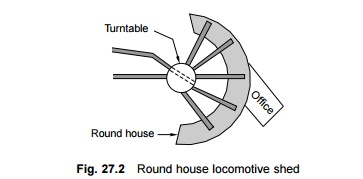Chapter: Civil : Railway Airport Harbour Engineering : Railway Engineering : Equipment at Railway Stations
Equipment at Railway Stations: Locomotive Sheds

Locomotive Sheds
Locomotive or running sheds are
meant for the maintenance and servicing of locomotives. The location and design
of a locomotive shed depends on the volume and pattern of traffic, the layout
of the terminal station and the marshalling yard, and other allied factors.
Locomotive sheds are normally spaced at about 250 to 300 km apart in order to
avoid the idle movement of locomotives and crew. Locomotive sheds are basically
of two types.
Homing sheds These are
provided to house locomotives and attend to their maintenance and
servicing. Equal stress is laid on the servicing and maintenance of locomotives
in these sheds. These sheds are normally designed to house about 80 to 100
locomotives.
Turn round sheds These are
provided for servicing locomotives and bringing them back to the homing
sheds. They may also be provided for attending to certain minor repairs. These
sheds are normally designed to hold about 30 to 50 locomotives.
1 Layout of Locomotive Sheds
The layout of locomotive sheds is
normally of three different types, namely, round house type, rectangular type,
and mixed type.
Round house locomotive shed
The round house shed (Fig. 27.2) consists of a
number of locomotive repair and stabling lines radiating from a turntable in
the centre. The shed is normally in the shape of a circle or a polygon. The
incoming engine is taken to the turntable and transferred to a particular line
for repair. The provision of a turntable eliminates the need for shunting.

The locomotive enters and leaves
from the same end and, therefore, in the event of the turntable becoming
inoperative, the movement of all the locomotives is discontinued until the
turntable is repaired. This type of shed layout is not recommended for Indian
Railways.
Rectangular-type locomotives shed
These sheds (Fig 27.3) are rectangular in shape
and are most commonly used on Indian Railways. A rectangular-type shed can be a
blind shed, a through shed, or a mixed-type shed. In the blind type of shed,
all the repair bays terminate at dead ends and locomotives can enter and exit
from one end only, thus leading to conflicts in the movement of the
locomotives. However, these types of sheds are cheap because they save on the
amount of space needed for tracks and turnouts at the rear end. Such
rectangular sheds can be planned for small locomotive holdings.

In a through rectangular shed,
the locomotives move from one end to the other in the correct sequence of the
operations that are to be performed for servicing. Such a shed offers
considerable scope for future expansion and tenders the maximum flexibility in
shed operations.
Mixed-type shed
A mixed-type shed has the
characteristics of both a blind and a through type. These sheds are suitable
for locations that require expansion in the near future but lack the requisite.
2 Essentials of a Well Laid Out
Locomotive Shed
A locomotives shed should satisfy the following conditions.
(a) As far as
possible, the design of the shed should allow the engines to move only in one
direction. The multidirectional movement of the engine, apart from creating
unsafe conditions, would invariably slow the engine down and cause them to be
unduly detained.
(b) The
design should be such that the time taken by the engine in passing through the
shed is reduced to the minimum.
(c) The
layout should be such that it is possible to skip one or more stages of
servicing, as all engines do not require the entire cycle of servicing.
(d) There
should be adequate stabling accommodation, both covered and open, for all
engines.
(e) There
should be adequate facilities for the servicing and repairs of engines.
(f) There
should be a separate shed for carrying out heavy repairs involving the lifting
of engines or dropping of wheels.
(g) It should
be provided with an adequate water supply for the servicing of locomotives as
well as for domestic use.
(h) There
should be provision for stores and a tool room for general maintenance and
repair work. Adequate office accommodation should also be made available for
the supervisors and the staff.
(i) The
sequence of operations normally followed in locomotive sheds is as follows:
inspection ® cooling ® turning ® fire
cleaning ® placement
® repairs ® outgoing inspection ® departure to traffic yard.
Related Topics